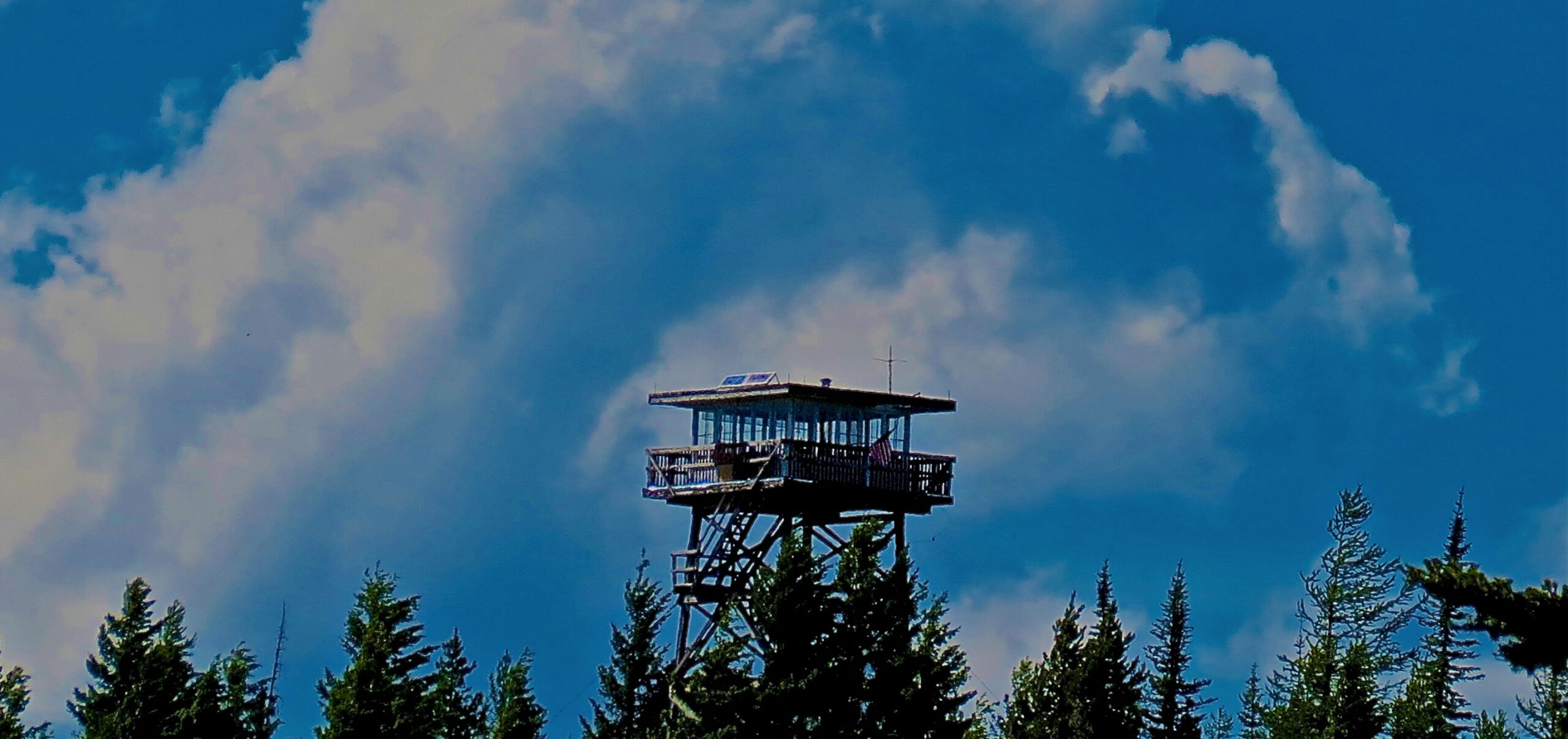Levi Brinegar is a fire lookout who can spot lightning from 70 miles away. His job, for a few months or weeks a year, is to look out for fires in a national park in Montana. Keeping an eye out for lightning is naturally an important part of the job.
To help him spot the fire, he lives on top of a mountain in a 15-b-15-foot tower. When lightning strikes he has to sit in a chair with insulators on all four feet to stop himself getting electrocuted. It’s an exciting life to say the least – or is it? In truth, I’ve come to realise, exciting and inspiring and boring and lonely are words that don’t really describe the life of a lookout. Talking to them, it’s more a feeling or a tone in their voice or the stories they tell that explain living alone in a tower.
Kjell Petersen grew up on a dairy farm in Iowa and had never seen a mountain or forest until he graduated from high school. When his family took a vacation to the mountains he felt hopelessly lost – but in a good way.
“I got a forestry and horticulture degree, and then spent 30 years working for the US Forest Service”, he tells me over Zoom. “My second summer, as a temporary employee, I staffed a fire tower for the entire summer in Idaho. That’s what got me hooked on lookouts”.
Fire lookout towers came into existence after 1910, when a massive fire swept across western America. The Forest Service was created and in the 1930s and 1940s, towers began to sprout up. By the 1970s there were around 5,000 towers in the US. Airplanes and satellites have slowly taken over, and now the number of manned towers hovers between 400 and 450.
My second summer, as a temporary employee, I staffed a fire tower for the entire summer in Idaho. That’s what got me hooked on lookouts
After 30 years of working in fire management, Petersen retired. His love for lookout towers, however, endured. Now Petersen helps run a non-profit organisation called the Forest Fire Lookout Association – to be exact, the organisation’s northwest Montana chapter. The group generates funds to refurbish and rehabilitate lookouts. He runs their Facebook page and even designed the chapter’s website, a treasure trove of information and stunning photographs.
He is also a volunteer with the US Forest Service, which means he gets to do what he loves – watch out for fires.
If a fire kicks off, lookouts have a set of tasks they have to carry out so that the Fire Service can decide whether or not to do something about the fire. They first have to figure out where it is, what is fuelling it and how it is behaving. They then radio the fire in to a centralised dispatch centre, which reports it to the responsible agency. After that it is up to the agency to decide whether to tackle the fire or allow it to run its course.
Most days, of course, there are no fires, meaning life – on the face of it – gets pretty dull, lonely and monotonous. But from speaking to fire lookouts, this is only true depending on what way you look at the world around you. A life some see as boring and lonely can in fact be spectacular and fulfilling.
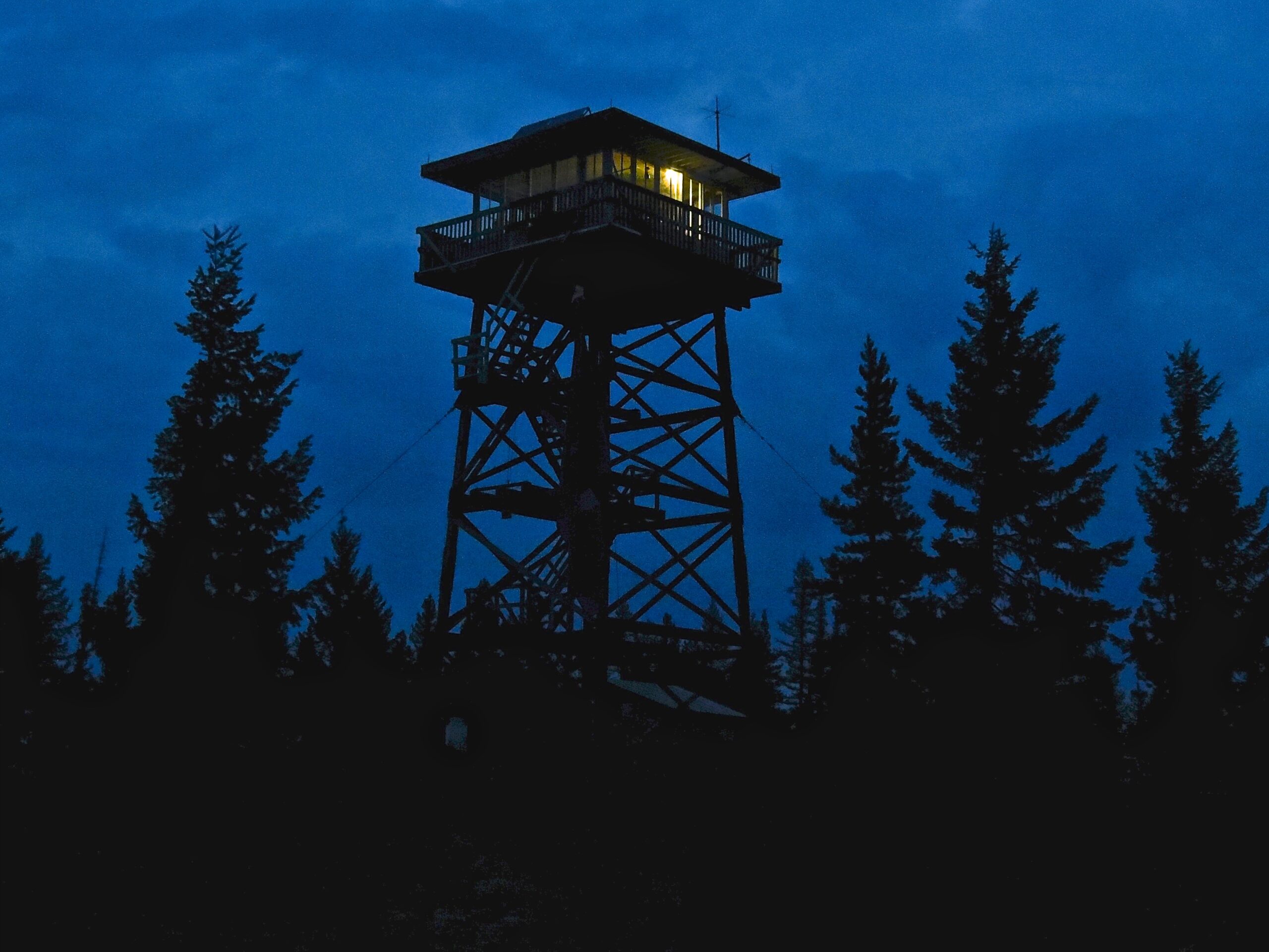
The Forest Service first started to build fire watch towers in the 1930s and 1940s. Bt the 1970s, 5,000 towers were in operation.
Petersen says that loneliness doesn’t really come into the equation: “When people come visit me on the tower now, when I’m staffing up as a volunteer, the most common question I get is, don’t you get lonesome up here? And my answer is always: this is the only place I’m not lonesome.”
“Because the solitude is so immense, and all the junk food in the world, and all the junk food in the news, and the media goes away. And suddenly, life goes into super slow motion”, he says, “and you just focus on what’s happening this minute”.
“You don’t think about an hour from now, or a day from now or a week from now. So suddenly, your whole spirit just washes clean, and you’re only focused on the fact that you hear the wind blowing, or you’re looking at the trees swaying in the breeze, or you’re hearing a pack of wolves that are down at the base of the tower doing a family howl, and life just slows down. And that is the most inexpensive therapy that you will ever experience.”
Brinegar had a different route to the towers, getting a job as a lookout after finishing up in the military. The Fire Service like to hire veterans: they tend to be reliable and know what to do in a pinch – particularly in unforgiving circumstances. Bringegar tells me that he’s naturally a loner and liked to travel so a job in the mountains of Montana was perfect for him. He gave in his notice at the steels mills in Philadelphia and headed into the wilderness.
Brinegar gets satisfaction from just knowing he is helping out.
You don’t think about an hour from now, or a day from now or a week from now. So suddenly, your whole spirit just washes clean
“Within a couple months, I went from being around one million people to just by myself on top of a mountain with no one for miles. I also had the opportunity to just help out – just be of service, to save these woods, because these fire lookouts – it’s a dying breed. And it’s sad to know that these towers are going down.”
“I’m not too sure why that is”, he adds. “But I really do wish that they would have more fire lookouts. Especially in California.
Brinegar, however, does feel the heaviness of loneliness. “It can wear you out mentally”, he says. “Your mood starts changing and you may get a little more angrier than you are. Even get into a depression mindset. I do like to be alone, but interaction with humans is nice at times.”
To help cope, Brinegar brings with him some distractions. He has a TV and video games. He also has his dog Stella at his side and goes on hikes with her. He particularly likes to watch horror movies up in the tower – being alone on a mountain must add to the creepiness.
Aside from the idyllic lifestyle, lookouts are witnessing firsthand the devastating effects of climate change. Petersen, for example, has been watching the climate change for 40 years – now, he says, fire season starts at least a month earlier and can go on for a month or two longer than they used to.
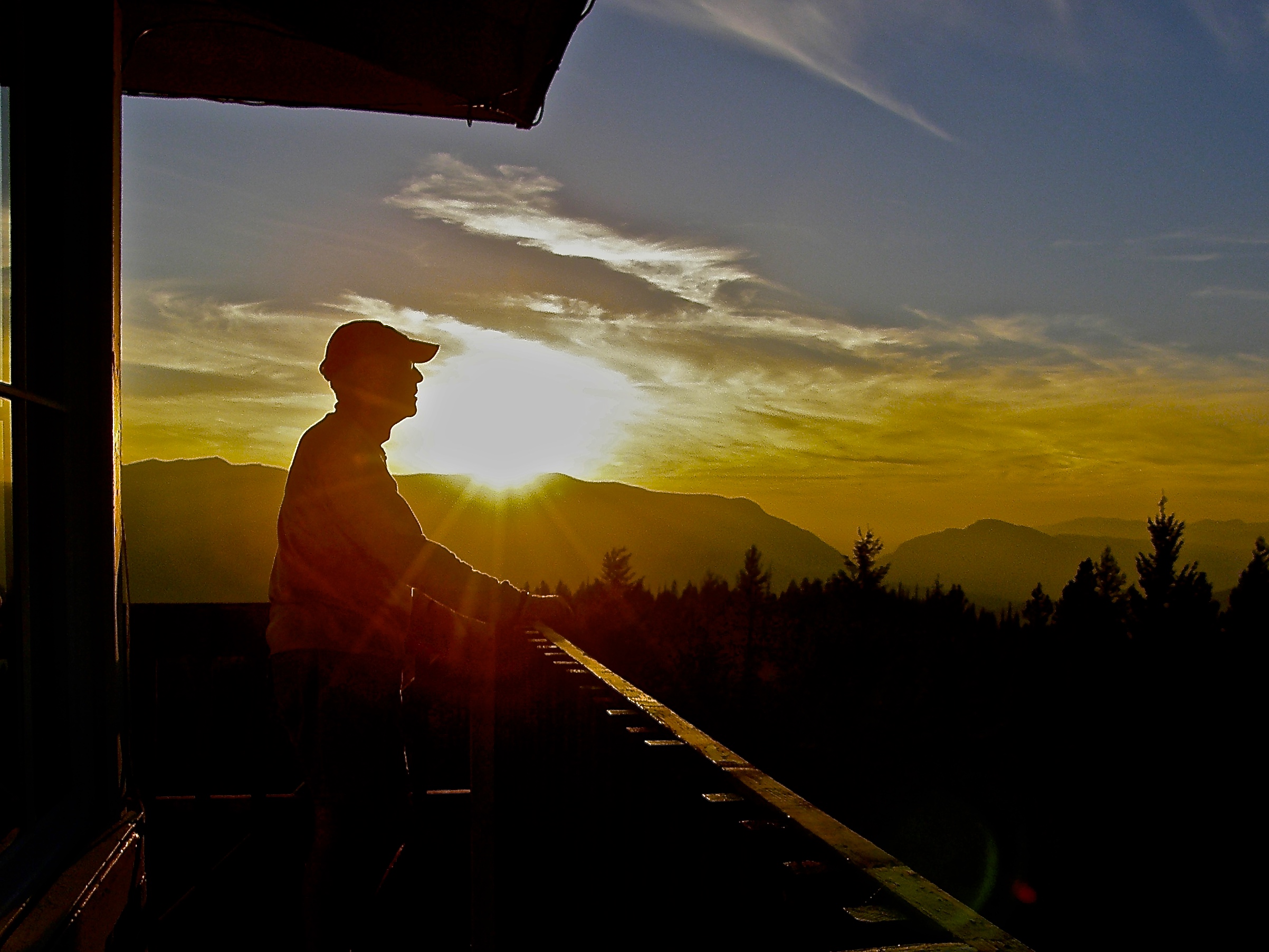
Kjell Petersen surveys the vast expanse of the Montana wilderness.
“I’ve always said, the people that deny climate change don’t look out the window very often”, he tells me.
Unfortunately, as climate change speeds up, the number of lookouts continue to decline. Samsara Duffey – a lookout in the Northern Rockies in Montana – puts the shift towards satellites and electronic surveillance and away from human lookouts down to a change in culture society wide.
“It’s really easy to think that technology is going to be our savior for everything. And so yeah, it’s cool. Let’s jump on the bandwagon”, she tells me.
But often technology falls short of what people can bring to the table – and often people are a better investment than pricey equipment.
“One thing that forest fires do is called a holdover time, where there will actually be a lightning strike, and it sits there and it smolders deep in the tree, and it may be two or more weeks later before that actually gets enough wind and enough fuel to spark up and be a forest fire again”, Duffey tells me. “And so the nice thing about having an observer in place like me is I’m sitting there watching that spot.”
I’ve always said, the people that deny climate change don’t look out the window very often
Lookouts also provide visitors who stumble across the towers – or actively seek them out – with lessons on fire safety. Duffey tells me that a large part of her job is talking to people who visit her tower.
“I have a chance to talk to them about how forest fires work, the fire ecology of the area in the forest in the area, and the animals in our area.”
Petersen also opens his doors to visitors when they come and gives them a tour of his place – just a bed, a stove, a fridge, a desk and some cabinets. He also shows them the Osborne firefinder, in his words, a “weird piece of equipment that sits in the middle of every tower”. The name is pretty self explanatory.
Thanks to the towers, people out in the wild learn something perhaps they wouldn’t have otherwise – through curiosity or luck. Our twitter feeds were bombarded this year with photos of Australia and California seemingly bursting into flames over night. Surely, besides the actual lookout work, educating people about fire safety and being in nature – understanding the real life effects of climate change – is important enough to find the money to pay for a manned lookout tower?
“Unfortunately, people see lookouts as antiquated and not necessarily fulfilling a role”, Duffey says. “And so it’s an easy one to say: ‘Oh, let’s not staff that.’ When really, they could not fly an aircraft for two or three hours and pay for our lookouts’ entire season.”
Once fire season ends – or a lookout’s stint in their tower ends – those used to living in the solitude of the mountains or the forest can struggle to get back into the swing of things.
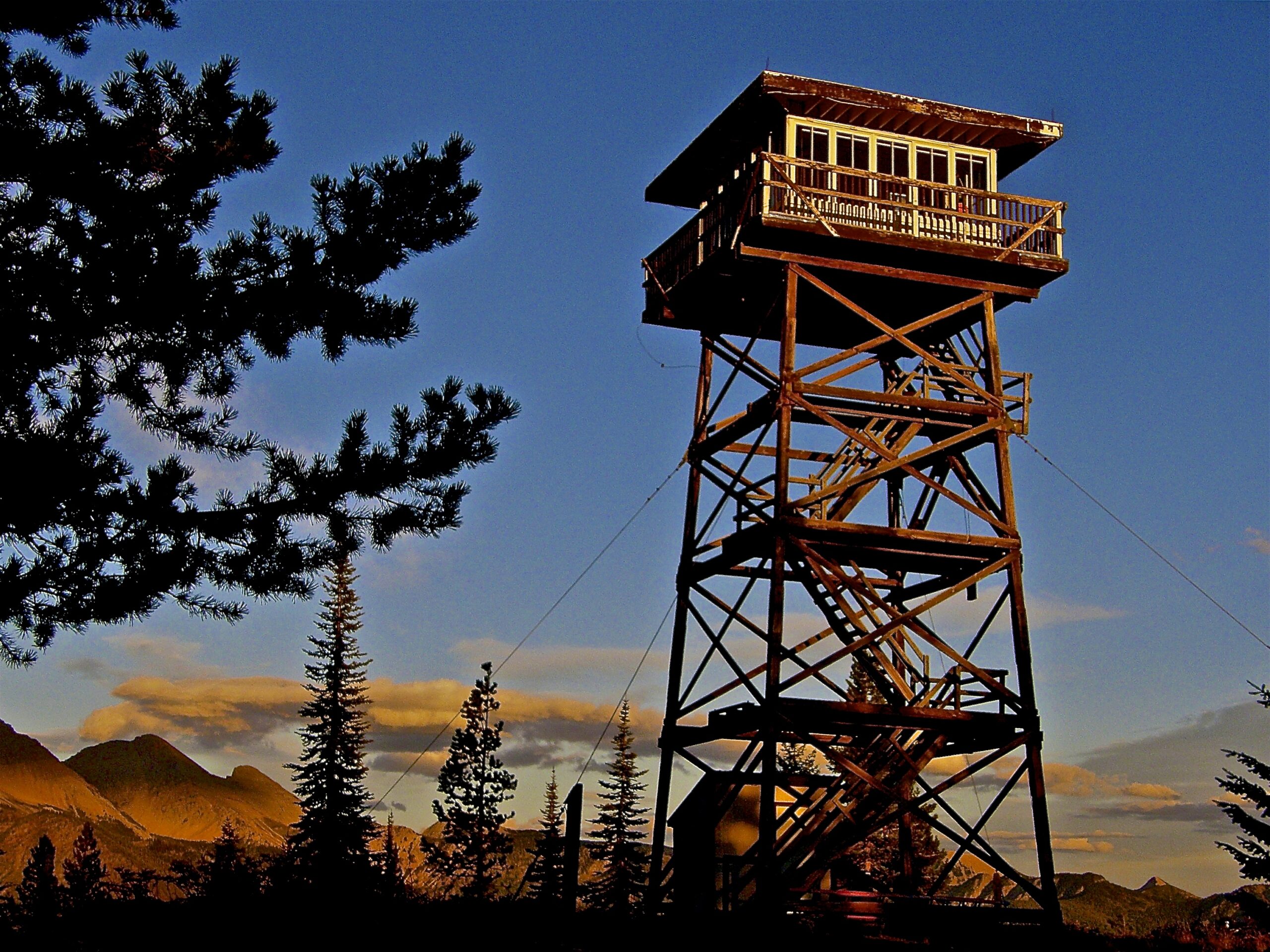
Fire lookout towers have fallen out of favour in the past few decades, as the government replaces lookouts with technology.
Petersen says that coming back to normal life in the town where he lives can be challenging. Volunteers usually spend two weeks or 10 days up in the towers. The summer of 2019, Petersen spent a month in a tower, and he says he had to lock himself away for a couple of days when he got home.
“You have to go from this super slow motion mentality and then ease back into high-speed living, and that doesn’t happen with a snap of a finger. It takes a day and a half or two to adjust one direction or the other.”
Aside from the slowed-down nature of lookout life, Petersen says that you also get to witness what he calls “God moments” – moments where a lookout sees nature and nature’s power in a way that few of us really get to in our daily lives.
“When you’re down on the ground, and you see lightning flashing around in the hillside, you don’t think a lot about it, because you’re down below it”, he tells me. “But when you’re in that tower, you are right in the middle of that lightning storm, and it’s not unusual for the tower to be struck by lightning.”
A tower getting struck by lightning isn’t necessarily dangerous for its inhabitants – a massive tower often on top of a mountain is unsurprisingly a common target for lightning. You just don’t want to get in between the stove and the fridge – the electricity arcs between metal objects and getting in the way can be fatal.
But aside from the danger, you also get to experience one of these God moments. These moments are not necessarily confined to thunderstorms. I get the impression that ordinary lookout life is peppered with such moments – I can hear it in Petersen’s voice when he talks about simply getting lost looking out the window.
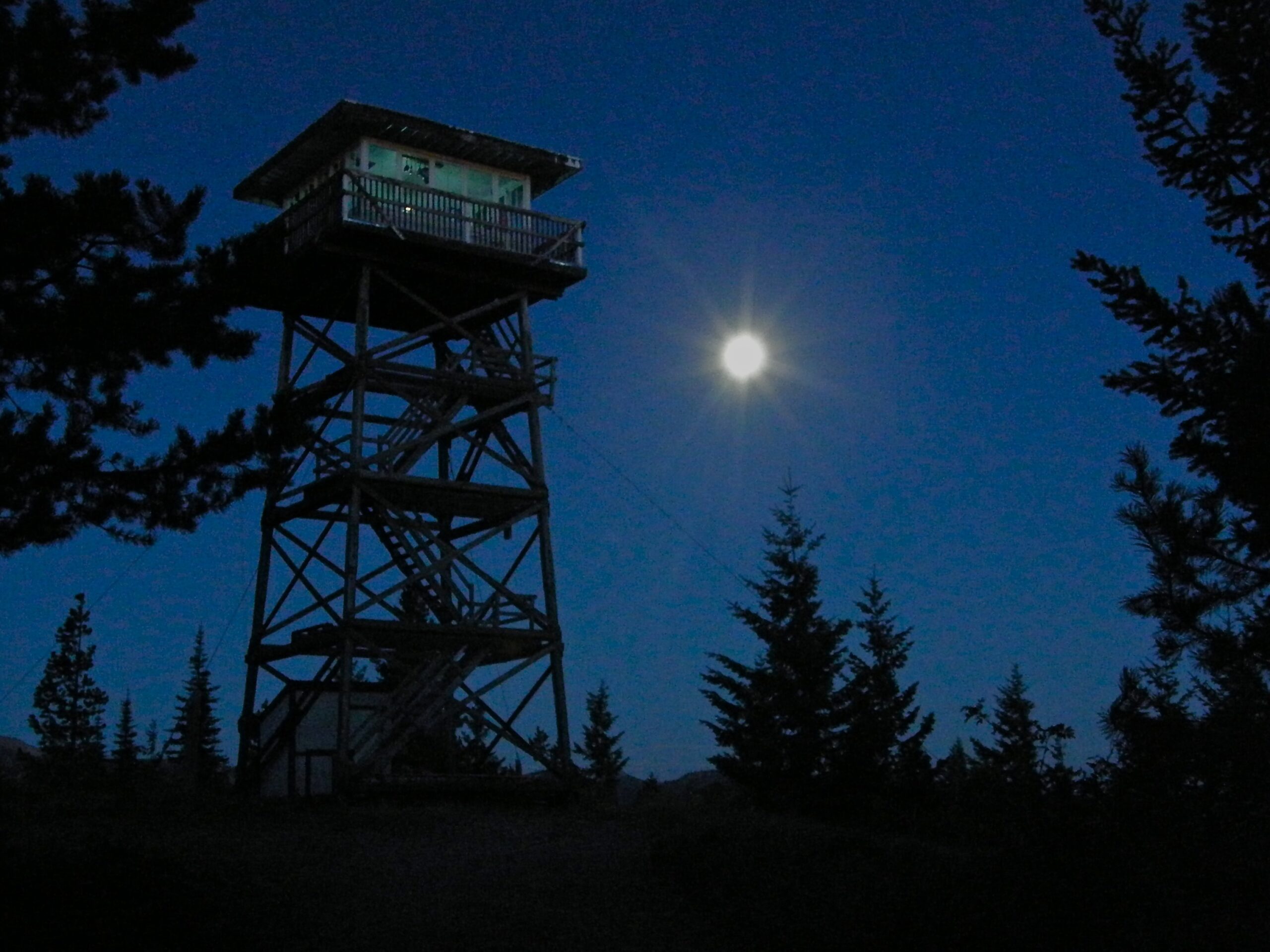
Kjell Petersen says that lookouts experience ‘God moments’, such as spectacular lightning storms.
“One of my other most favorite moments happened three years ago – it was an August morning, clear and quiet. I had all the doors and windows open. I was eating my oatmeal for breakfast, and a local wolf pack started a family howl.”
“And I just sat there for about 15 minutes, listening to this primordial thing to your soul, listening to these wild animals howling and I remember that I had to remind myself to breathe, because it was just such a unbelievable thing to sit there and witness.”
Brinegar echoes Petersen’s sentiment.
“The thing that I enjoy most about the job is knowing that people aren’t seeing what I’m seeing”, he tells me. “People don’t see the lightning as close as I do. People don’t go through the weather that I go through. It’s my own, personal experience. I’m not downtown going grocery shopping, like everyone else does or anything at the moment. I’m up there, weathering it out, seeing things that people just don’t see.”
These natural phenomena, not induced by human beings – simply happening unprompted – are clearly special. But lookout life also seems to dramatise the mundane things that we don’t even think to notice.
“The north side of the lookout looks right at the Big Dipper”, Petersen tells me, “so when I go to bed at night, the Big Dipper is sitting up in the sky here, and then as the Earth spins during the night, when I wake up in the morning, the Big Dipper is over here in the sky”.
I just sat there for about 15 minutes, listening to this primordial thing to your soul, listening to these wild animals howling and I remember that I had to remind myself to breathe
“I have learned over time that when I wake up in the middle of the night – lookouts wake up two or three or four times in the middle of the night – and they just sit up and look around to see if anything’s going on. I don’t have to look at a clock anymore because I just know by where that big dipper is in the sky, what time it is.”
Petersen says that being a fire lookout makes you realise “that you are so outrageously bombarded with bullshit in your regular life”.
I feel that all the lookouts are in agreement on this one. Being a lookout allows them to get away from the humdrum of normal life and escape into nature. Duffey knits, listens to countless audiobooks, hikes with her dog. Brinegar does work on his tower, plays video games and watches movies. Petersen witnesses the world spinning and listens to the wolves howl. It’s a life totally alien to city folk.
“When you get to a place where it all goes away”, Petersen says, “it’s just immensely therapeutic, where you can just focus on what’s going on in your own head, and the rest of the world goes away for a little while”.
Perhaps in our solitude – even if we are locked in our rooms rather than out in the wild – this is a perspective that we can all embrace as we face into a seemingly endless lockdown.
Correction: 21:25, March 15th, 2021
A previous version of this article incorrectly referred to Kjell Petersen as Kjell Lama.
